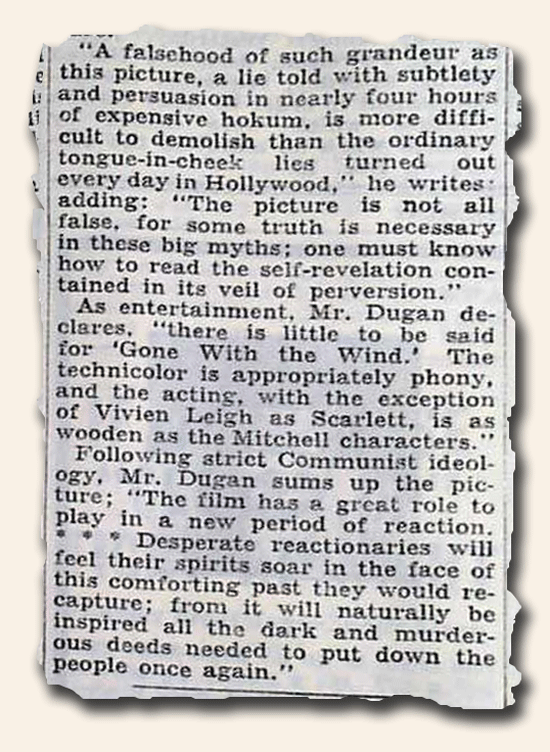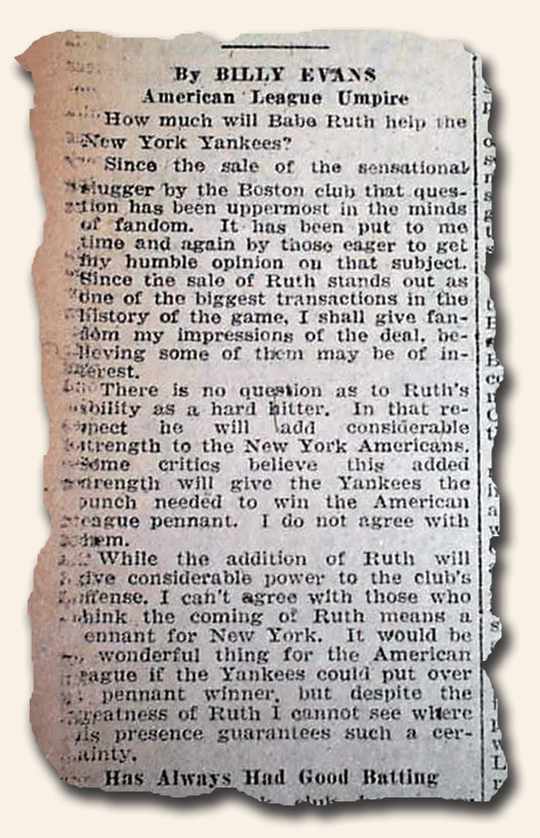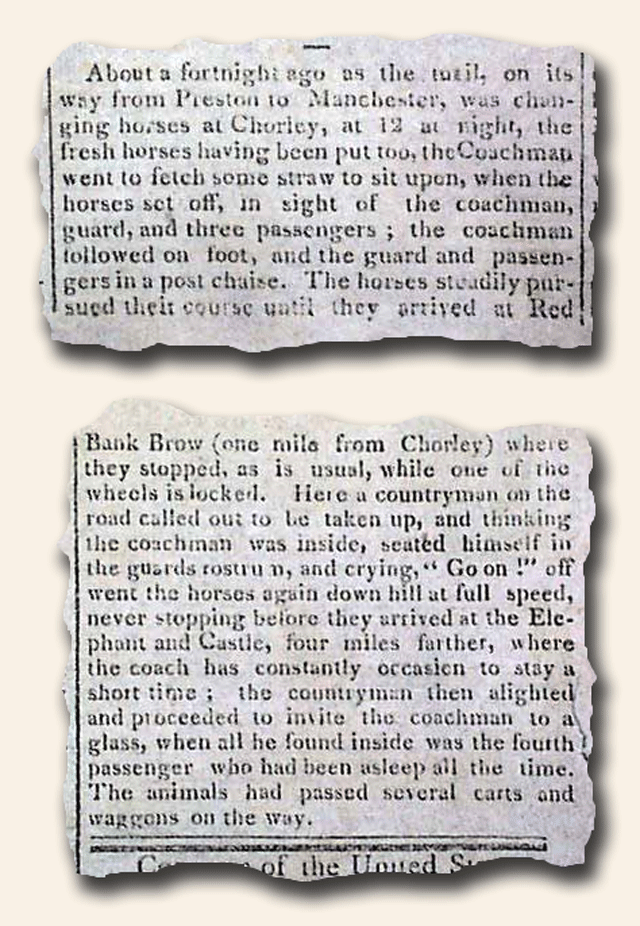Rare Newspapers… What to collect?
March 31, 2011 by GuyHeilenman · 1 Comment
There are an infinite number of ways to approach collecting rare newspapers. The History’s Newsstand Blog is pregnant with suggestions. Over the course of the next several months we will  begin to explore the topic in earnest. For those who are new to the hobby, and are anxious to explore what has been written to-date, the following links are to help bring you up to speed:
begin to explore the topic in earnest. For those who are new to the hobby, and are anxious to explore what has been written to-date, the following links are to help bring you up to speed:
Feel free to share your thoughts on ideas for collecting rare and early newspapers: themes, eras, topics, etc.
The “experts” don’t always get it right…
March 28, 2011 by GuyHeilenman · 2 Comments
We recently unearthed two different newspapers which scream the reality “the experts are often wrong”. The first report was an early review of “Gone With The Wind” which was not favorable (issue #580564). The 2nd was a statement concerning Babe Ruth which occurred soon after he was traded to The New York Yankees which questioned whether he would be an impact player (issue #581104). Interestingly enough, the opinion was given by Billy Evans, one of the most famous umpires (and member of the Hall of Fame) of all time. Feel free to comment on similar finding of your own. In the meantime, enjoy the reports:
Babe Ruth…
It never caught on…
March 26, 2011 by TimHughes · Leave a Comment
This “Novel Hydraulic Railway Locomotive” made the front page of “Scientific American” on Feb. 10, 1877, with a descriptive article which begins: “A new mode of traveling has lately been invented…”. Apparently it never caught on:
The Traveler… Booker T. Washington facing court… “Reach out, reach out and touch someone”…
March 24, 2011 by The Traveler · Leave a Comment
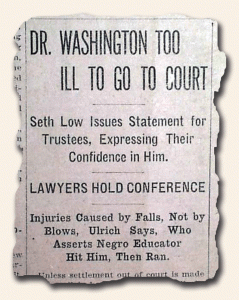 A few days ago I traveled to New York City through the New York Tribune dated March 21, 1911 (I’m running a little behind schedule). The front page of the issue carries the report of “Dr. (Booker T.) Washington Too Ill To Go To Court”. I found that this was an interesting assault case between Dr. Washington and Henry A. Ulrich, re: who attacked whom. I had to google this case to find the verdict. What I found was that this case/verdict has become known for extreme injustice due to Mr. Ulrich acquittal. However, he was re-arrested in the courtroom for desertion of his wife!
A few days ago I traveled to New York City through the New York Tribune dated March 21, 1911 (I’m running a little behind schedule). The front page of the issue carries the report of “Dr. (Booker T.) Washington Too Ill To Go To Court”. I found that this was an interesting assault case between Dr. Washington and Henry A. Ulrich, re: who attacked whom. I had to google this case to find the verdict. What I found was that this case/verdict has become known for extreme injustice due to Mr. Ulrich acquittal. However, he was re-arrested in the courtroom for desertion of his wife!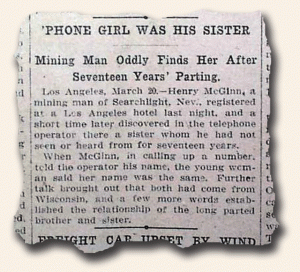
Also in this issue is the reporting of the funeral for John B. M’Donald, the builder of the subway system in New York… I guess he made his final stop.
Do you remember when you actually were able to talk with a “live” operator when calling information? When Henry McGinn reached the operator and conversation ensued, he found that the operator was his sister whom he had not seen or heard from for seventeen years! A reunited relationship occurred from the “reach out, reach out and touch someone…” archives.
~The Traveler
First newspapers in Ohio…
March 21, 2011 by TimHughes · Leave a Comment
 Ohio was still part of the vast Northwest Territory when the first newspaper in present-day Ohio was published in 1793. The date was November 9 and William Maxwell’s newspaper the “Centinel of the North-Western Territory” was the first product of the printing press anywhere north of the Ohio River & west of the Allegheny & Blue Ridge mountains. The city of publication was Cincinnati, but just a few years earlier it’s name had changed from “Losantiville”. The newspaper would continue until June of 1796, although records show the newspaper was sold to Edmund Freeman in 1796 who changed the name to “Freeman’s Journal“. Records show, however, that it did not publish until July of 1800 and lasted less then 6 months.
Ohio was still part of the vast Northwest Territory when the first newspaper in present-day Ohio was published in 1793. The date was November 9 and William Maxwell’s newspaper the “Centinel of the North-Western Territory” was the first product of the printing press anywhere north of the Ohio River & west of the Allegheny & Blue Ridge mountains. The city of publication was Cincinnati, but just a few years earlier it’s name had changed from “Losantiville”. The newspaper would continue until June of 1796, although records show the newspaper was sold to Edmund Freeman in 1796 who changed the name to “Freeman’s Journal“. Records show, however, that it did not publish until July of 1800 and lasted less then 6 months.
The second newspaper published in Ohio was also done in Cincinnati, called the “Western Spy and Hamilton Gazette“, begun in May of 1799 and lasting till the end of 1822. Only one other pre-statehood (1803) newspaper published in Ohio, being the “Scioto Gazette” published in Chillicothe, it beginning January 8, 1801 and lasting through the end of 1803.
A proportionate reward…
March 19, 2011 by TimHughes · Leave a Comment
Sometimes we read things which drive home the futility of human wisdom. Solomon would certainly have cringed at the following verdict which appeared in the “Democratic Watchman” newspaper from Bellefonte, Pennsylvania, dated February 23, 1877:
Galt, California, among our Old West titles…
March 17, 2011 by TimHughes · Leave a Comment
We have many issues of the “Weekly Galt Gazette“, California, in our Old West inventory, but perhaps few of our collectors know this city–current population of some 23,000, in Sacramento County–had its start in the California Gold Rush.
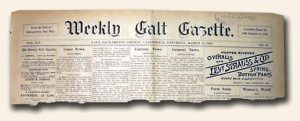 In 1850, a group of farmers settled around the banks of a small stream, Dry Creek, close to Galt. Their plans were to grow beef and dairy products. In the year 1869, the town of Galt was laid out by the Western Pacific Railroad Company. The name Galt was given at the request of John McFarland, a local rancher, in honor of his home town in Canada. It was previously called Dry Creek Township after the stream by which they settled. By 1869, the community consisted of blacksmiths, dairymen and cattle ranchers. Raising cattle was the main occupation.
In 1850, a group of farmers settled around the banks of a small stream, Dry Creek, close to Galt. Their plans were to grow beef and dairy products. In the year 1869, the town of Galt was laid out by the Western Pacific Railroad Company. The name Galt was given at the request of John McFarland, a local rancher, in honor of his home town in Canada. It was previously called Dry Creek Township after the stream by which they settled. By 1869, the community consisted of blacksmiths, dairymen and cattle ranchers. Raising cattle was the main occupation.
Galt was built almost entirely of wooden structures making fires the biggest problem for the town. However, many of the old original homes are still standing, in excellent preservation, around town.
In 1880, Galt had two general merchandise stores, one variety store, one hotel, one harness shop, two blacksmith shops, two wagon and carriage manufacture and repair shops, one wood yard, one livery stable, two barber shops, two shoe stores, two saloons, one meat market, one barely mill, Wells Fargo & Co.’s Express Office with three physicians and one attorney-at-law in town.
By the turn of the century, cattle raising and dairying gradually decreased and agriculture took over. The principal grain was wheat.
(credit: City of Galt)
First newspapers in North Dakota…
March 14, 2011 by TimHughes · Leave a Comment
The Dakota Territory organized in 1861 encompassed both present-day North & South Dakota. It was in 1889 when statehood was gained that the Territory was split into North & South.
 But it was during the Civil War, in 1864 when two solders issued at Fort Union (present-day North Dakota) a newspaper called the “Frontier Scout” Only a few numbers were printed at Fort Union. A bit later it reappeared with a “Fort Rice, D.T.” imprint and a date of June 15, 1865, noted as “vol. 1, No. 1”. It is not known to have continued after 1865.
But it was during the Civil War, in 1864 when two solders issued at Fort Union (present-day North Dakota) a newspaper called the “Frontier Scout” Only a few numbers were printed at Fort Union. A bit later it reappeared with a “Fort Rice, D.T.” imprint and a date of June 15, 1865, noted as “vol. 1, No. 1”. It is not known to have continued after 1865.
It was not until July of 1873 when the first permanent newspaper appeared in the Territory, located at the capital of Bismarck and titled the “Tribune“. It started as a weekly but 8 years later became a daily, which it remains to this day. It boasts that it has never missed an issue, although because of a winter blizzard it was forced to reduce its size & one number was printed on wallpaper.
Not long thereafter the second newspaper in North Dakota began, titled the “Express“, printed at Fargo on Jan. 1, 1874. The third newspaper, and in yet a third city, was the “Plaindealer” which published at Grand Forks in 1874 as well.
It’s all relative…
March 12, 2011 by TimHughes · Leave a Comment
The following item reflects court costs from 1877, fees which are very much in the distant past. But it’s all relative. While the cost may have outweighed the benefit, sometimes things are still worth fighting for – on matters of principle. This appeared in the “Democratic Watchman” newspaper from Bellefonte, Pennsylvania, dated February 16, 1877: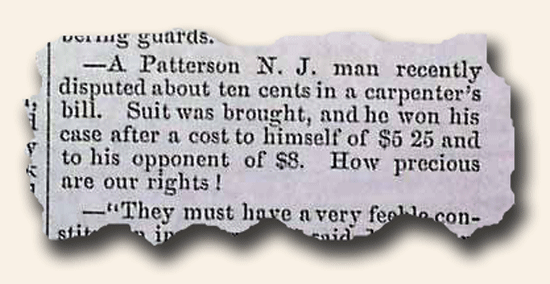
The Traveler… Maine becoming a state?… the horses know the way!…
March 10, 2011 by The Traveler · Leave a Comment
This week’s journey found me with the Middlesex Gazette issue dated March 7, 1811. This contained a headline “Another New State” in which the District of Maine (a part of the state of Massachusetts) had held a Convention in Boston and voted 56 to 18, that “it is expedient to take the sense of the people on a separation from Old Massachusetts.” However, they did not obtain their statehood until nine years later as part of the Missouri Comprise.
An amusing story (see below) is of a Coachman, who while fetching some straw for his seat, found his horses leaving without him. They proceeded to the next place (with the coachman in chase) and stopped as they would normally do. A countryman entered and called “go on!” and the horses took off again at full speed to the next place, four miles away. Early auto-pilot?



